Belém
The quiet area of Belém, or rather Santa Maria de Belém, is a green area with many parks and gardens located at the mouth of the River Tagus. From here the earlier explorers departed to new worlds, bringing back enormous wealth, which funded the construction of large monuments such as the Torre de Belém (Tower) and the Mosteiro dos Jeronimos (Monastery).
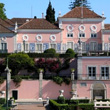 Palácio de Belém:
Palácio de Belém:
The palace was originally built in the 16th century by Manuel of Portugal, the nobleman of Aveiras. In the 18th it changed ownership (D. João V) and built a riding school which is now the Museu Nacional dos Coches, the carriage museum. In 1911 the palace was designated as the official residence of the President, but not all former presidents actually lived here.
Address: Calçada da Ajuda 11
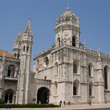 Mosteiro dos Jerónimos :
Mosteiro dos Jerónimos :
On behalf of D. Manuel I, the construction of the monastery started in honour of Saint Mary of Belém. The Mosteiro dos Jeronimos is the replacement of the previous church where the monks of Christ order gave support to the sailors. This unique Manuel architectural style building has Gothic elements from the Renaissance period with lots of royal symbolism.
Nearly a century after the start, the monastery was completed and the ‘new’ monks of the Order of St. Jeronimos function was to pray for the soul of the king, and to give spiritual assistance to the sailors who left the Praia do Restelo (the beach) behind them towards discovering new countries. D. Manuel I and his descendants were later buried in marble tombs located in the chancel of the church, and in the side chapels.
Address: Praca do Imperio
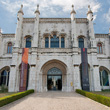 Museu Nacional de Arqueologia:
Museu Nacional de Arqueologia:
Since 1893, the archaeological museum is located in the west wing of the Jeronimos Monastery, in the former dormitories of the monks. It houses the most important archaeological research in Portugal and has a collection of findings from around the country. For example the permanent collection of Egyptian antiquities, Portuguese treasures from the Bronze and Iron Ages, and a collection of Roman mosaics from southern and central Portugal.
Address: Praca do Imperio
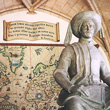 Museu da Marinha:
Museu da Marinha:
The Maritime Museum is housed in the west wing of the Jeronimos Monastery, next to the archaeological museum. The chapel, built by order of Infante D. Henrique (Henry the Navigator), was where the sailors gathered to attend Mass before they departed on their long journeys in search of new worlds. Since 1962, you can go here for replicas of 16th century maps, navigation instruments, and scale models of ships.
Address: Praca do Imperio
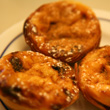 Confeitaria de Belém:
Confeitaria de Belém:
In the Confeitaria de Belem, you can eat the world famous delicious puff pastry tarts with a sort of crème brûlée filling called Pasteis de Belem. Every day some 10,000 of these tartlets with a secret recipe get sold here! You can eat in one of the rooms decorated with painted azulejos (tiles) while the Paseis de Belém is still warm with powdered sugar and cinnamon … That is if you can get a seat, despite the huge crowds.
Note: Pasteis de nata, which you can get all over Portugal, are very similar the Pastel de Belém. But which ones are the best? You have to discover that yourself.
Tip: buy some at the desk, individually, or in our case, more of them, and take them to the shore, so you can eat them while enjoying the sunset at the Padrão dos Descobrimentos.
Address: Praca do Imperio
Link: Confeitaria de Belém
Adres: Rua de Belém 84-92
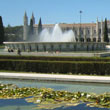 Praça do Império:
Praça do Império:
The square, or praça in Portuguese, has an area of 3.3 hectares and was built in 1940 for the Grande Exposição do Mundo Português, the Great Exhibition of the Portuguese World, and is located directly in front of the Mosteiro dos Jeronimos. In the middle of the garden there is a large garden with a fountain at the spot where there once was a beach, the Praia do Restelo, before the Tagus changed its course.
Address: Between the Avenida da India and the Avenida da Rua de Belém.
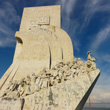 Padrão dos Descobrimentos:
Padrão dos Descobrimentos:
Belém used the be the starting point from where the Portuguese navigators left to go and explore new worlds. In 1960, at 500 years anniversary of the death of the Infante D. Henrique (Henry the Navigator), saw the inauguration of the Padrão dos Descobrimentos, monument of the discoveries, which has the shape of a ship. ‘On board’ are many heroes of Portuguese history with on the bow Infant D. Henrique – the inspiration for the discovery voyages. Other famous characters include: Vasco da Gama – who discovered India, Pedro Álvares Cabral – discoverer of Brazil, and Luis de Camões – Portugal’s greatest poet. Between all these men you will find one woman, the mother of the Infante D. Henrique.
The compass on the floor in front of the monument, can best be seen from the 50m top. The map shows the routes of the discoveries of the 15th and 16th centuries.
Tip: Padrão is at its best in the magical light of late afternoon.
Address: Avenida de Brasília
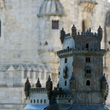 Torre de Belém:
Torre de Belém:
The Torre de Belém was built between 1515 and 1521 in an era, when defending the entrance of the Tagus and the city centre was of the upmost importance. The tower was originally built in the middle of the river, but due to the changing course of the river, it is now close to the shore. The tower has visibly Moorish influences, but is mainly built in Manuel-style with decorations such as the crosses of the Military Order of Christ. In 1580 it was converted into a prison after the tower had lost its function as a fortress and the storage rooms were converted into dungeons. Also, it functioned as a lighthouse and telegraph station.
Address: Avenida da India

